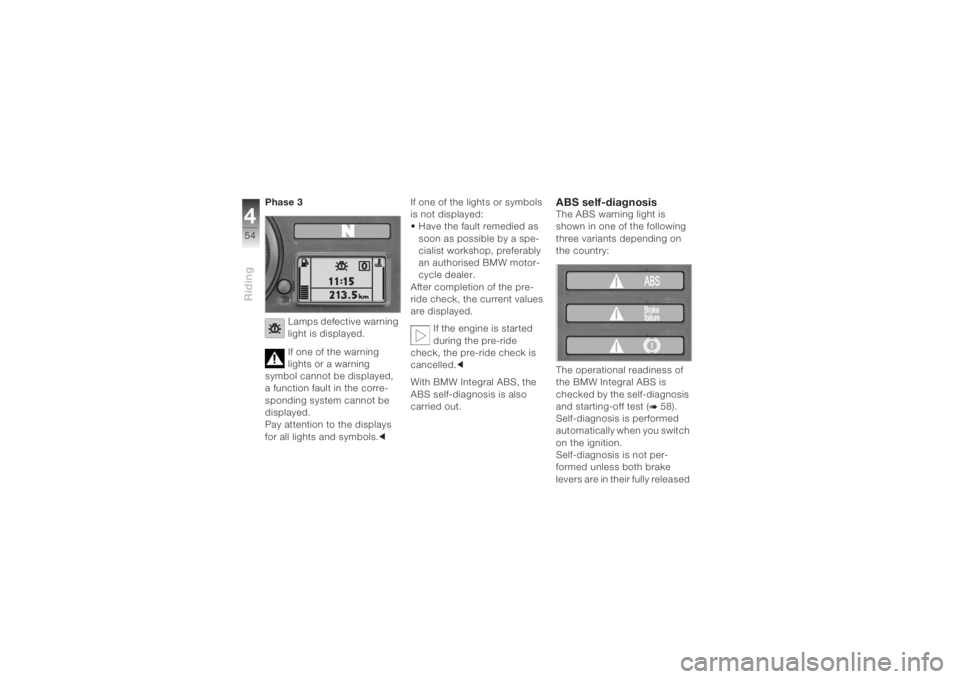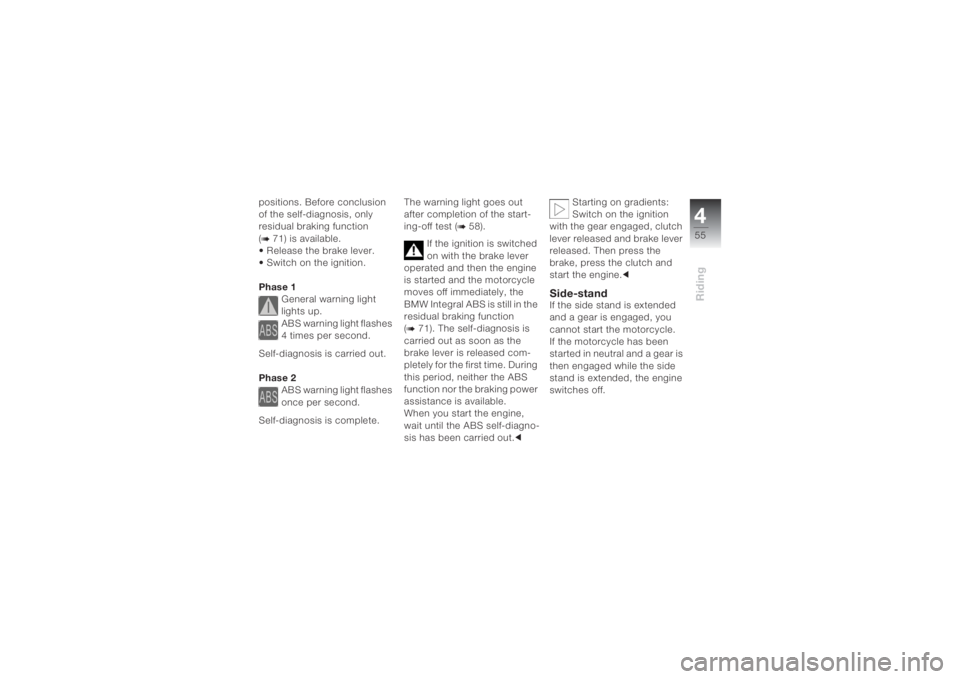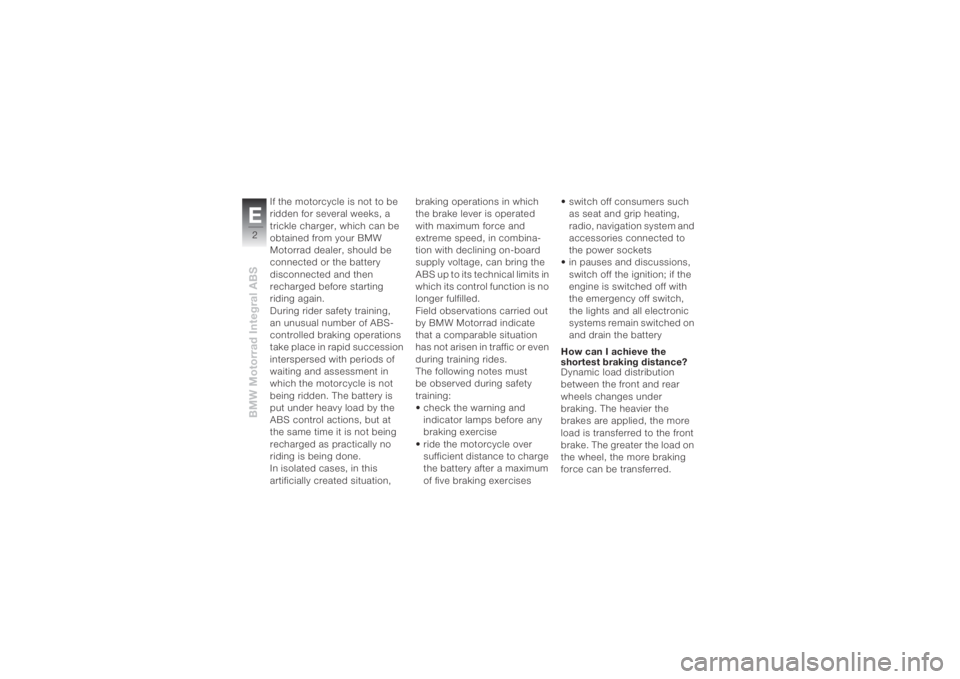Page 55 of 162
453Riding
Before you startSwitching on the ignition• Read the information on the
EWS (
b 22).
• Kill switch1 in operating
positionA.
• Switch on the ignition.
» Pre-ride check is carried out.
» With BMW Integral ABS:
ABS self-diagnosis is
performed.
Pre-ride checkAfter the ignition has been
switched on, a pre-ride check
is carried out. Here, the func-
tions of all warning lights and
warning symbols are checked.
The following are displayed in
succession in the multifunc-
tion display:
Phase 1
General warning light
lights up red.
Engine oil pressure
symbol is displayed.Battery charge current
symbol is displayed.
Phase 2
General warning light
lights up yellow.
Engine electronics
symbol is displayed.
EWS symbol is
displayed.
Page 56 of 162

Riding454
Phase 3
Lamps defective warning
light is displayed.
If one of the warning
lights or a warning
symbol cannot be displayed,
a function fault in the corre-
sponding system cannot be
displayed.
Pay attention to the displays
for all lights and symbols.cIf one of the lights or symbols
is not displayed:
• Have the fault remedied as
soon as possible by a spe-
cialist workshop, preferably
an authorised BMW motor-
cycle dealer.
After completion of the pre-
ride check, the current values
are displayed.
If the engine is started
during the pre-ride
check, the pre-ride check is
cancelled.c
With BMW Integral ABS, the
ABS self-diagnosis is also
carried out.
ABS self-diagnosisThe ABS warning light is
shown in one of the following
three variants depending on
the country:
The operational readiness of
the BMW Integral ABS is
checked by the self-diagnosis
and starting-off test (
b 58).
Self-diagnosis is performed
automatically when you switch
on the ignition.
Self-diagnosis is not per-
formed unless both brake
levers are in their fully released
Page 57 of 162

455Riding
positions. Before conclusion
of the self-diagnosis, only
residual braking function
(b 71) is available.
• Release the brake lever.
• Switch on the ignition.
Phase 1
General warning light
lights up.
ABS warning light flashes
4 times per second.
Self-diagnosis is carried out.
Phase 2
ABS warning light flashes
once per second.
Self-diagnosis is complete. The warning light goes out
after completion of the start-
ing-off test (
b 58).
If the ignition is switched
on with the brake lever
operated and then the engine
is started and the motorcycle
moves off immediately, the
BMW Integral ABS is still in the
residual braking function
(
b 71). The self-diagnosis is
carried out as soon as the
brake lever is released com-
pletely for the first time. During
this period, neither the ABS
function nor the braking power
assistance is available.
When you start the engine,
wait until the ABS self-diagno-
sis has been carried out.cStarting on gradients:
Switch on the ignition
with the gear engaged, clutch
lever released and brake lever
released. Then press the
brake, press the clutch and
start the engine.c
Side-standIf the side stand is extended
and a gear is engaged, you
cannot start the motorcycle.
If the motorcycle has been
started in neutral and a gear is
then engaged while the side
stand is extended, the engine
switches off.
Page 58 of 162
Riding456
Manual gearboxThe motorcycle can be started
in the neutral position or with a
gear engaged and the clutch
pressed. Only press the clutch
after switching on the ignition.
In the neutral position, the
"neutral" telltale light lights up
in green and the gear display
in the multifunction display
shows 0.Starting
Do not turn the throttle
twistgrip when starting
the engine. At ambient tem-
peratures below 0 °C, disen-
gage the clutch after switching
on the ignition.c• Press starter button1.
» The engine starts.
• Observe warning and infor-
mation displays (
b 18-28).
The start attempt is auto-
matically interrupted if
the battery voltage is too low.
Prior to renewed starting
attempts, charge the battery
or obtain starting assistance
(
b 111).cHigh engine speeds with
a cold engine could lead
to increased engine wear.
Avoid high engine speeds
when the engine is cold.c
If you are unable to start
the engine, the following
troubleshooting chart can
provide assistance.c
Page 107 of 162
6105
Maintenance
• Place your left hand on the
left grab handle of the motor-
cycle 4, and your right hand
on the lever of the rear wheel
stand 5.
• Raise the motorcycle, simul-
taneously pressing the lever
downwards until the motor-
cycle stands vertically.• Press the lever onto the
ground.
BulbsInformation on bulbsThe failure of a bulb is sig-
nalled in the display by the
defective lamp symbol. If the
brake or rear light fails, the
general warning light also
lights up yellow.
If the rear light fails, the brake
light is used as a substitute in that the luminosity of the
second glow filament is
reduced to rear light level. Fail-
ure of the rear light is still
shown in the display.
In the event of a lamp
failure, there can be
problems seeing and being
seen.
Replace defective bulbs as
soon as possible; preferably
always carry appropriate
reserve lamps.c
You will find an overview
of the types of bulb used
on (
b 136).c
Page 153 of 162
i151
Index
FFront-wheel stand, 103
Fuel
Filler aperture, 11
Fuel gauge, 18
Quality, 68, 134
Refuelling, 67
Reserve display, 22
Fuel tank capacity, 68
Fuses, 135GGear indicator, 18
Gearbox
Gear shifts, 59
Position on starting, 53
Technical data, 128
General view
Left side, 9
Right side, 11
Grip heating, 13, 35
HHandlebar controls
Left, 12
Right, 13
Hazard warning
flashers, 12, 32, 33
Headlight
Adjustment for right-hand/left-
hand traffic, 38
Overview, 15
Headlight flasher, 12, 37
Headlights
Adjusting the vertical aim, 9
Helmet holder, 9, 41
High-beam headlight
Bulb, 15
Replacing the bulb, 107
Switching on, 12, 37
Telltale light, 18
Horn, 12
IIgnition
Switching off, 30
Switching on, 30, 53
Inflation pressures, 126
Installing the battery, 115
Instrument cluster, 14JJump starting, 111KKeys
Ignition keys, 30
Replacement keys, 32
Kill switch, 13, 34LLaying up, 120
Low-beam headlight
Bulb, 15
Replacing the bulb, 106
Switching on, 37
Page 155 of 162
i153
Index
Frame and suspension, 129
Fuel and lubricants, 132
Information, 5
Power transmission, 128
Riding specifications, 138
Wheels, 131
Telltale lights, 14, 18
Tightening torques, 124
Toolkit, 11, 85
Tripmaster, 12, 18, 33
Turn indicator
Left, 12
Replacing the front bulb, 109
Replacing the rear bulb, 110
Right, 13
Turn indicators
Switching off, 13, 40
Switching on, 39
Telltale lights, 18
Type plate, 11
VVehicle identification number, 11WWarning indicators
Notes, 19
Overview, 20
Warning lights, 14, 18
Warnings, 4
Wheels
Checking the rims, 94
Checking the tread depth, 94
Checking the tyre pressure, 47
Fitting the front wheel, 97
Fitting the rear wheel, 100
Makes, 94
Removing the front wheel, 95
Removing the rear wheel, 99
Technical data, 131
Tyre pressures, 126
Page 160 of 162

BMW Motorrad Integral ABSE2
If the motorcycle is not to be
ridden for several weeks, a
trickle charger, which can be
obtained from your BMW
Motorrad dealer, should be
connected or the battery
disconnected and then
recharged before starting
riding again.
During rider safety training,
an unusual number of ABS-
controlled braking operations
take place in rapid succession
interspersed with periods of
waiting and assessment in
which the motorcycle is not
being ridden. The battery is
put under heavy load by the
ABS control actions, but at
the same time it is not being
recharged as practically no
riding is being done.
In isolated cases, in this
artificially created situation, braking operations in which
the brake lever is operated
with maximum force and
extreme speed, in combina-
tion with declining on-board
supply voltage, can bring the
ABS up to its technical limits in
which its control function is no
longer fulfilled.
Field observations carried out
by BMW Motorrad indicate
that a comparable situation
has not arisen in traffic or even
during training rides.
The following notes must
be observed during safety
training:
• check the warning and
indicator lamps before any
braking exercise
• ride the motorcycle over
sufficient distance to charge
the battery after a maximum
of five braking exercises• switch off consumers such
as seat and grip heating,
radio, navigation system and
accessories connected to
the power sockets
• in pauses and discussions,
switch off the ignition; if the
engine is switched off with
the emergency off switch,
the lights and all electronic
systems remain switched on
and drain the battery
How can I achieve the
shortest braking distance?
Dynamic load distribution
between the front and rear
wheels changes under
braking. The heavier the
brakes are applied, the more
load is transferred to the front
brake. The greater the load on
the wheel, the more braking
force can be transferred.Info_I_ABS_en_xx.fm Seite 2 Dienstag, 19. Juli 2005 2:48 14
Page:
< prev 1-8 9-16 17-24